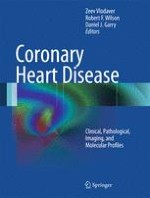Gepubliceerd in:
2012 | OriginalPaper | Hoofdstuk
29. Prevention of Coronary Artery Disease
Abstract
Many cardiovascular risk factors are involved in the development of coronary artery disease (CAD). Evidence-based medicine has taught us that lifestyle modifications such as a heart-healthy diet, smoking cessation, daily exercise, and optimal weight control have a significant impact on reducing cardiovascular morbidity and mortality. This chapter discusses these interventions as well as the role of antihypertensive, antiplatelet, and cholesterol-lowering therapies.
Despite the enormous progress in primary and secondary CAD prevention in the past few decades, the residual risk is still important, and therefore, continuous intensive research is mandatory in this field. Joint National Committee (JNC) VIII and Adult Treatment Panel (ATP) IV will guide us for the next decade in better qualitative and quantitative approaches for the preventive management of CAD.
